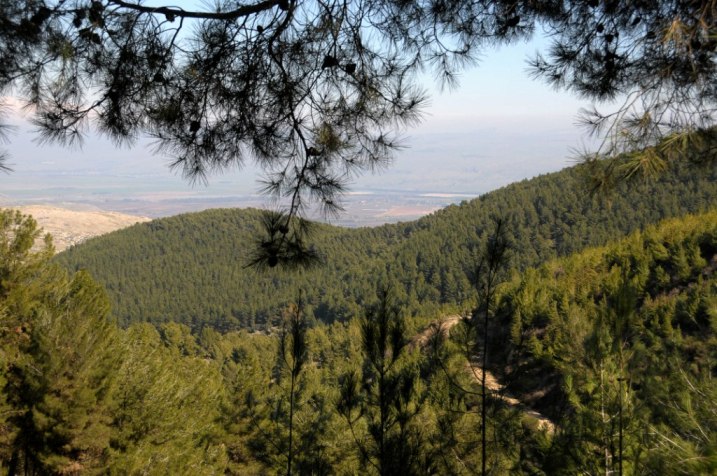Ovnit on:
[Wikipedia]
[Google]
[Amazon]
Jamnith ( gr, Ἰαμνειθ), also Jabnith, Yavnit (), Iamnia, or in medieval parlance, Ibnit / Abnit / Ovnit, is a ruin in the Upper Galilee that came to renown during the First Jewish Revolt in the 1st-century CE. The ruin, known locally by the name ''Khurbet esh-Sheikh Banit'', or simply ''Kh. Banît'', lies about to the northeast of 

File:Har Yavnit seen from the east side.jpg, View of Har Yavnit from east
File:Old foot path strewn with broken shards leading from Jamnith ruin.jpg, Old footpath leading up to Jamnith (Kh. Banit)
File:Entrance to alleged burial cave of Abayye and Rava.jpg, Alleged burial cave of Abaye and Rava
File:Rava and Abayye.jpg, Stone inscription at alleged burial site of Abaye and Rava
File:Observation point on Har Yavnit.jpg, Visitors' observation point on Har Yavnit
File:Shrine built for R. Yudan Nesiah.jpg, Shrine built as memorial to R. Yudan Nesiah, Har Yavnit
File:Modern structure made from reused stones found at Jamnith.jpg, Modern stone structure at Har Yavnit, made from reused stones found at Kh. Banit
File:General view from road ascending Har Yavnit.jpg, View from Har Yavnit, looking north
IAAWikimedia commons
{{DEFAULTSORT:Jamnith Geography of Israel Archaeological sites in Israel First Jewish–Roman War Ancient Jewish settlements of Galilee Former populated places in Israel Upper Galilee Geography of Palestine (region) Geography of Northern District (Israel)
Safed
Safed (known in Hebrew language, Hebrew as Tzfat; Sephardi Hebrew, Sephardic Hebrew & Modern Hebrew: צְפַת ''Tsfat'', Ashkenazi Hebrew pronunciation, Ashkenazi Hebrew: ''Tzfas'', Biblical Hebrew: ''Ṣǝp̄aṯ''; ar, صفد, ''Ṣafad''), i ...
, in the Biriya Forest, and was once a fortified town towards the northeast of Mount Canaan ( Hebrew: ''Har Kena'an''), upon a hill called ''Har Yavnit''. The hill on which the village ruins lie rises above sea level and overlooks the Hula valley. Access to the ruin is now restricted because of an enclosed military installation built over the site.
The village is mentioned twice in the writings of Josephus as being in the Upper Galilee; once in ''The Jewish War'' (2.20.6) under the appellation Ἰαμνειθ, and again in ''Vita'' §37 under the name Ίαμνια, and is distinguished from the Jamnia of Judaea. Josephus testifies of himself that he assisted in building the wall of the village, the reference perhaps being to funding its building project. The hilltop fortress has no natural spring, suggesting that its inhabitants relied upon rock-cut cisterns for water, of which several can be found on the site.
The fate of the town's defenders is not known, but they are presumed to have surrendered after the fall of Tarichaea.
Victor Guérin visited the site in the late 19th-century and found on the plateau of the elevated hill, which he called ''Kharbet Benit'', what he described as "a village, now overthrown from top to bottom, and of which there are only many piles of stones from demolished houses." Earlier, in 1838, the site was visited by Edward Robinson, who wrote, "here (Benit) are the slight remains of a former village, situated directly on the brow of the mountains enclosing the Huleh, and commanding a splendid view over the whole basin and the surrounding region."
Michael Avi-Yonah thought that the priestly course known as Bilgah had its place of residence in ''Yavnit''.

Identification
While most modern historical geographers are unanimous as to Jamnith's identification with the ruin ''Kh. Banit'', Edward Robinson and Eli Smith who surveyed the ancient sites ofPalestine
__NOTOC__
Palestine may refer to:
* State of Palestine, a state in Western Asia
* Palestine (region), a geographic region in Western Asia
* Palestinian territories, territories occupied by Israel since 1967, namely the West Bank (including East ...
were uncertain of its location. Neubauer Neubauer or Neubaur is a surname. Notable people with the surname include:
*Adolf Neubauer, Rabbinical scholar
*Alfred Neubauer, Mercedes Grand Prix racing manager
*Chuck Neubauer, Pulitzer Prize-winning American journalist
*Dagmar Neubauer, German ...
thought that the site of ''Jamnia'' in Galilee may have been identical with Yabneel of the Hebrew Bible (), a place later known as ''Kefar Yammah''. However, this last site is not in the Upper Galilee.
Jamnia, known as ''Ibnit'', had been resettled by local Arabs as late as 1948.

Rabbinic burial ground
Jewish tradition holds that Talmudic scholars Abaye andRava Rava may refer to:
Biographical
* Bishnu Prasad Rabha, multifaceted artist and revolutionary singer of Assam
* Abba ben Joseph bar Ḥama (born 280), a Jewish Talmudist who lived in Babylonia, always known by the honorific name ''Raba,'' ''Rava, ...
are buried in a cave shown on ''Har Yavnit'' (Ovnit). R. Yudan Nesi'ah, upon whom was conferred the title of '' nasi'', is also said to have been buried on the mountain,Levi-Naḥum, Yehuda (1986), p. 252, chapter: Tombs of the forefathers and righteous s.v. באבנית along with his two sons. Visitors may access the burial sites as they lie outside the restricted area. The mountain affords a good prospect of the Hula valley on its east and southeastern side, including the town of Rosh Pina and the northern part of the Sea of Galilee
The Sea of Galilee ( he, יָם כִּנֶּרֶת, Judeo-Aramaic: יַמּא דטבריא, גִּנֵּיסַר, ar, بحيرة طبريا), also called Lake Tiberias, Kinneret or Kinnereth, is a freshwater lake in Israel. It is the lowest ...
.
Gallery
References
Bibliography
* * * * * * * * * * * * (first printed in Leipzig 1907)External links
* Survey of Western Palestine, Map 4IAA
{{DEFAULTSORT:Jamnith Geography of Israel Archaeological sites in Israel First Jewish–Roman War Ancient Jewish settlements of Galilee Former populated places in Israel Upper Galilee Geography of Palestine (region) Geography of Northern District (Israel)